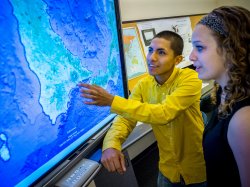Here are some resources with Lesson Plans:
Understanding by Design & Its Correlation to CCSS
If we examine the way CCSS are set up, we recognize that generally speaking, the anchor standards/domains give us an overall picture of the literacy and problem-solving skills that students are expected to master in order to be prepared for college and their future careers. The individual grade level pages provide content-specific criteria. These long- and short-term goals allow educators to identify the objectives they want their students to meet. Assessments are designed based on these objectives, and lessons are created and instructed to lead students to knowledge acquisition and skill achievement.
This progression resembles the Understanding by Design (UbD) framework for lesson preparation first advocated by Jay McTighe and Grant Wiggins in their 1998 book of the same name. The UbD framework can be described as backward planning and is broken down into three main stages: (1) Desired Results, (2) Evidence, and (3) Learning Plan. The purpose of UbD is to purposefully design curriculum so that students acquire knowledge by creating and then ensuring that assessments and lessons meet targeted learning goals. The term ‘essential question’ is a large component of UbD, and it is similar to the CCSS anchor standards/domains because both strive to master a “big idea” that allows for investigation and exploration. Learning is not done by chance or by accident; teachers create authentic experiences where all students have the opportunity to learn. The following video is an overview of the UbD framework:
Video: What is UbD?
Digital Curation
Now that you have some background knowledge in both the components of the Common Core State Standards and Understanding by Design, we must decide the ways that we collect resources in order to design lessons that integrate the CCSS.
Digital curation describes a process of making saved resources accessible from anywhere. Four major actions can be considered when thinking about digital curation.
Selecting
Users search for content and decide on resources they wish to keep for future reference. These resources can include links to webpages, videos, audio, and downloadable materials. Selection can be done by uploading content from a saved computer or searching for resources online. When you are searching for information to use, you want to make sure you are searching effectively so you can get the information you are looking for. There are several tips you can use to modify your searches to be more specific.
Collecting
Users compile the resources and save them to an access point, which can be a file sharing/saving webpage, or a digital social bookmarking webpage. Collections can be shared with other users to maximize the exchange of resources. The best part about all of these webpages is that you can access the content you have saved from anywhere! Saving on your computer or browser only allows you to view the bookmarks on that device.
The following webpages allow you to upload, save, and organize content “in the cloud” so you can log in to utilize your bookmarks:
Maintaining/Archiving
Users can maintain and archive resources by adding tags, folders, or other types of categories to make resources more organized and easier to navigate.
